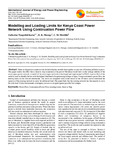| dc.contributor.author | Karue, C.N | |
| dc.contributor.author | Murage, D.K | |
| dc.contributor.author | Muriithi, Christopher M. | |
| dc.date.accessioned | 2017-09-05T07:32:39Z | |
| dc.date.available | 2017-09-05T07:32:39Z | |
| dc.date.issued | 2016 | |
| dc.identifier.citation | International Journal of Energy and Power Engineering 2016; 5(6): 182-188 | en_US |
| dc.identifier.issn | ISSN: 2326-960X | |
| dc.identifier.uri | http://hdl.handle.net/123456789/2792 | |
| dc.identifier.uri | http://www.sciencepublishinggroup.com/journal/paperinfo?journalid=164&doi=10.11648/j.ijepe.20160506.12 | |
| dc.description.abstract | Shore to ship power connection for docked ship has recently been applied as one way of limiting pollution in ports.
This paper studies the effect that a shore to ship connection at the port of Mombasa would have on the voltage stability of the coast region power network. A model of the coast region network is developed and implemented in PSAT. A power flow of the model is used to identify the bus with the highest likelihood of experiencing voltage collapse. Using continuation power flow, the loading limits on this bus are determined. The limits are compared with a load model of the off-shore load to determine the capacity of the existing network to carry the additional load. The paper finds that the existing network has the capacity to carry the extra load. It also recommends contingency actions to mitigate against possible line outages. | en_US |
| dc.language.iso | en | en_US |
| dc.subject | Power Flow, | en_US |
| dc.subject | Continuation Power Flow, | en_US |
| dc.subject | Shore to Ship | en_US |
| dc.title | Modelling and loading limits for kenya coast power network using continuation power flow | en_US |
| dc.type | Article | en_US |

